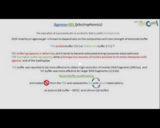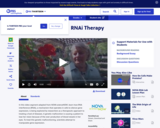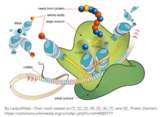
Some tips to prepare, load and run your agarose gel to analize your PCR product or digested vector!
- Subject:
- Life Science
- Material Type:
- Lecture
- Author:
- Manuele Martinelli
- Date Added:
- 02/22/2021

Some tips to prepare, load and run your agarose gel to analize your PCR product or digested vector!

This self-paced course was originally designed to help prepare incoming MIT students for their first Introductory Biology Course (known at MIT as 7.01). It will also be useful for anyone preparing to take an equivalent college-level introductory biology class elsewhere. It includes lecture videos, interactive exercises, problem sets, and one exam. Lecture Topics: Molecules of Life, The Cell and How it Works, Information Transfer in Biology, Inheritance and Genetics, and Building with DNA.
Go to OCW’s Open Learning Library site for Pre-7.01: Getting up to Speed in Biology. The site is free to use, just like all OCW sites. You have the option to sign up and enroll in the course if you want to track your progress, or you can view and use all the materials without enrolling.

This course provides a foundation in the following four areas: evolutionary and population genetics; comparative genomics; structural genomics and proteomics; and functional genomics and regulation.

In this video segment adapted from NOVA scienceNOW, learn about RNAi's potential to treat a wide range of genetic and infectious diseases.

This resource is a video abstract of a research paper created by Research Square on behalf of its authors. It provides a synopsis that's easy to understand, and can be used to introduce the topics it covers to students, researchers, and the general public. The video's transcript is also provided in full, with a portion provided below for preview:
"COVID-19, caused by the enveloped RNA virus SARS-CoV-2, primarily affects the respiratory and gastrointestinal systems. Disease severity varies substantially across patients; the disease is mild or asymptomatic in some cases and causes respiratory failure or death in others. SARS-CoV-2 viral RNA has been detected in fecal samples, suggesting that the gastrointestinal tract may be a site of viral replication. To better understand the effect of SARS-CoV-2 on resident gut viruses (the “gut virome”), researchers examined blood samples and fecal specimens from 98 patients with COVID-19 and 78 healthy individuals. Using shotgun metagenomics, they found that patients with COVID-19 had decreased abundance of certain RNA viruses and DNA-based bacteriophages. In contrast, environment-derived eukaryotic DNA viruses were enriched in COVID-19 patients..."
The rest of the transcript, along with a link to the research itself, is available on the resource itself.

A deep dive into how mRNA is translated into proteins with the help of ribosomes and tRNA.

In this seminar you will create a mental organization scheme to learn the central dogma theory in the steps of synthesizing proteins. Interactive games will help reinforce the process. You will model the process by creating coded (transcribing) secret messages and translating messages.StandardsBIO.B.2.2.1 Describe how the processes of transcription and translation are similar in all organisms.BIO.B.2.2.2 Describe the role of ribosomes, endoplasmic reticulum, Golgi apparatus, and the nucleus in the production of specific types of proteins.BIO.B.2.3.1 Describe how genetic mutations alter the DNA sequence and may or may not affect phenotype (e.g., silent, nonsense, frame-shift).

This resource is a video abstract of a research paper created by Research Square on behalf of its authors. It provides a synopsis that's easy to understand, and can be used to introduce the topics it covers to students, researchers, and the general public. The video's transcript is also provided in full, with a portion provided below for preview:
"Viruses are a critical component of biosphere and human ecosystems, directly influencing human health and disease and controlling the output of engineered ecosystems. Unfortunately for scientists studying them, most viral signals remain hidden in sequence datasets due to a lack of optimal identification tools. A new tool aims to make virus identification easier. VirSorter2 is a DNA and RNA virus identification tool that leverages genome-informed database advances to improve the accuracy and range of virus sequence detection. Compared with other tools, VirSorter2 performs more consistently with high accuracy across diverse viruses and minimized errors associated with atypical cellular sequences, including eukaryotic genomes and plasmids. VirSorter2 is also modular, allowing it to expand to newly discovered viruses through the design of new viral classifiers..."
The rest of the transcript, along with a link to the research itself, is available on the resource itself.

This resource is a video abstract of a research paper created by Research Square on behalf of its authors. It provides a synopsis that's easy to understand, and can be used to introduce the topics it covers to students, researchers, and the general public. The video's transcript is also provided in full, with a portion provided below for preview:
"A fundamental law of genetics states that offspring do not inherit traits from their parents that were acquired in response to environmental conditions. Recent research in the field of epigenetics, however, is turning this principle on its head. Several recent studies have come to the remarkable conclusion that unhealthy diets in males can contribute to the development of metabolic diseases in their offspring. Even when those offspring are raised with healthy diets_._ Now, a study has identified small RNAs as the molecules responsible for the transmission of these disorders. For a long time scientists thought that inheritance of traits only occurred via DNA being passed from parent to offspring. It is now clear, however, that the experiences of one generation can have an effect on the next. When parents have a high-stress lifestyle or an unhealthy diet, for example, chemical modifications can occur on genes that are then passed to their children. This is termed ‘epigenetic inheritance..."
The rest of the transcript, along with a link to the research itself, is available on the resource itself.

This resource is a video abstract of a research paper created by Research Square on behalf of its authors. It provides a synopsis that's easy to understand, and can be used to introduce the topics it covers to students, researchers, and the general public. The video's transcript is also provided in full, with a portion provided below for preview:
"RNA base editing has great potential for use in research for cell functions and genetic disease. Unlike DNA editing, which can cause unwanted mutations in other parts of the genome, RNA editing may allow researchers to mimic genetic variants that provide a health advantage. Two main RNA base editors have been used in vitro: REPAIR, which mediates A-to-I editing, and RESCUE, which can perform both C-to-U and A-to-I editing. Unfortunately, although RESCUE is more versatile, its low editing efficiency limits its applications. Now, researchers have developed an enhanced RESCUE (eRESCUE) system. eRESCUE was generated by fusing inactivated PspCas13b with ADAR2. In tests using human cell lines, eRESCUE mediated more efficient A-to -I and C-to-U RNA editing than the original RESCUE editor. eRESCUE editing of IKKβ successfully converted 177Ser to Gly, resulting in decreased phosphorylation and downregulation of downstream IKKβ-related genes..."
The rest of the transcript, along with a link to the research itself, is available on the resource itself.